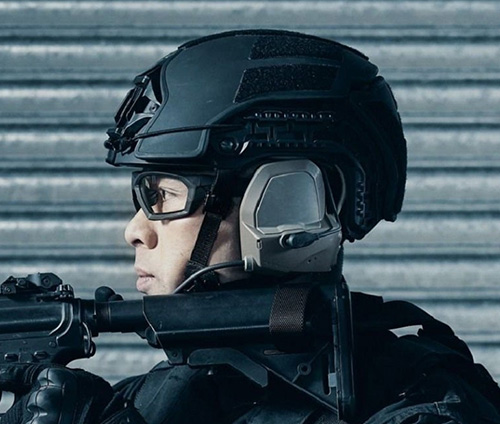NO SUCH THING AS AN ALL-IN-ONE SOLUTION:
The crucial differences between ballistic and public order helmets
When it comes to police head protection, there is no all-in-one, general purpose solution. Different operational scenarios demand specialized equipment tailored to their unique requirements and threats. A prime example of this is the distinction between ballistic helmets and public order helmets. While both are crucial for ensuring officer safety, attempting to create a hybrid public order helmet that also offers ballistic protection is ill-advised due to the stark differences in their design construction and intended purposes.
PURPOSE-BUILT DESIGN
Ballistic helmets are engineered to provide unparalleled protection against small, fast-moving projectiles, such as bullets fired from a handgun or fragments produced by an explosion. Despite the high velocity, the energy of these projectiles is actually smaller compared to heavy rocks or bottles potentially encountered during a riot. As a result, ballistic helmets employ a very hard outer shell, designed to stop these small, lightweight, and fast-moving objects that concentrate their energy on a limited area of the helmet’s surface. While ballistic helmets excel at stopping such threats, their primary focus is not on absorbing the overall impact, as the energy involved is relatively limited. Instead, the emphasis lies in preventing penetration and safeguarding the wearer’s head against the hyper focused energy of these projectiles.

Ballistic helmets are designed to absorb small, light objects moving at very high velocities, while public order helmets are built to absorb impact from larger, heavier objects and need the ability to absorb multiple hits.

On the other hand, public order helmets have an entirely different purpose. They are designed to absorb impact from heavier, higher energy objects, moving at a slower speed. A modern public order helmet has two principal protective components: a semi-hard outer shell, usually made from plastic, fiberglass, or a mixture of materials, and a soft, thick inner liner made of expanded polystyrene or polypropylene “EPS” foam. High quality public order helmets, like the Schuberth P100N, are built with aramid for additional cut resistance and FR properties found in the material. The P100N helmet from Schuberth combines multiple layers of aramid composite with an EPS foam backing. When the helmet is attacked, the exterior aramid fiber layers delaminate (or separate), dissipating some of the force before it reaches the interior EPS foam.
The hard outer shell serves two important purposes: preventing helmet penetration by pointed objects that could otherwise puncture the skull, and providing structural support to the inner liner, preventing it from disintegrating upon impact with items thrown or weapons striking it. This is particularly significant since the foams used in the inner liner have limited resistance to penetration. The foam liner’s purpose is to crush upon impact. The goal is to reduce the force and deceleration experienced by the user‘s head, thus minimizing the risk of traumatic brain injury (TBI) while maintaining a degree of structural integrity.
Understanding Head Injuries in Law Enforcement
To comprehend the importance of helmets, it is necessary to understand the mechanism of head injuries. Common perception may be that the primary purpose of a helmet is to prevent impact to the skull, and while this is obviously critically important, skull fractures are often non-life threatening unless the fracture is depressed and impinges on the brain. Bone fractures to the skull usually heal over a relatively short period of time. Neurological injuries suffered from head trauma can be more severe. Such injuries can lead to permanent disability, personality changes, or even death. Unlike bones, neurological tissues have limited regenerative capabilities after injury, underscoring the critical significance of helmet design in minimizing TBI risks.
Therefore, a carefully balanced structure with a rather thin outer shell that distributes the impact is needed. It needs to crack in a controlled fashion while keeping the outer layer intact. A hard ballistic shell would directly transfer the energy, overwhelming the foam liner, risking breakage and structural compromise. The foam under the shell will further absorb and distribute the energy over a wider area, reducing the risk of brain injury. This careful design permits partial, controlled cracking within a limited area while preserving structural integrity, enabling the helmet to provide multi-hit capability.
The distinctive nature of ballistic and riot threats necessitates different design approaches for each type of helmet. There is no all-in-one solution when it comes to police head protection. Ballistic helmets and riot control helmets serve entirely different purposes, and their design construction is optimized to address specific threats encountered in their respective scenarios. Attempting to create hybrid riot helmets that also offer ballistic protection is impractical and could compromise officer safety. Police users need to be equipped with dedicated, purpose-built helmets for each operational context, maximizing their effectiveness and safety in the line of duty.



 RAMPARTCORPUSA.COM
RAMPARTCORPUSA.COM